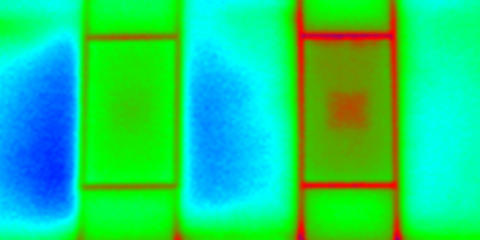
Infrared image of the outside wall of the control and test rooms. The test room, on the left, has undergone modifications. Its image shows significantly more blue (a colder temperature, less heat loss). The unmodified control room on the right shows little blue and much more green, orange and red colors that represent the warm air escaping to the outside.
Buildings account for 40 percent of the energy consumed within the United States and a similar percentage of carbon dioxide emissions. National Institute of Standards and Technology (NIST) engineers recently took a look at energy-related upgrades to their own quarters—and found energy-related improvements were well worth the expense. A NIST plan to act on the findings should save taxpayers money while helping meet a presidential order for federal agencies to cut energy consumption to 70 percent of 2003 levels by 2015.
The NIST researchers undertook their study using two adjacent offices in one of the general purpose buildings on the NIST campus. The building is typical of those constructed on the NIST campus in the early to mid-1960s. One of the two offices served as the control office and the second office was modified to reduce the flow of energy through the exterior wall. Each room was carefully instrumented to determine energy savings that could be realized through various energy savings options while maintaining identical levels of comfort.
The unmodified control office has a single-pane glass window unit and an antiquated heating and cooling unit. Thermal insulation was not present between the exterior walls of the office and the interior space. Significant air leakage occurred between the interior of the office and the outdoor air as a result of numerous gaps and voids in the exterior wall.
In the modified office all air leaks were sealed The exterior walls were insulated with approximately 9 inches of glass-fiber insulation and the more than 40-year-old single-pane glass window was replaced with a double-pane, argon-filled insulated glass window unit. A forced air heating and cooling unit was installed in the attic to deliver conditioned air to the office module, replacing the antiquated heating and cooling system that required piping in the office module walls. Energy upgrade expenditures came to approximately $2,825.
Measurements made to compare the energy required to maintain the control and modified office modules at identical conditions revealed a 59 percent savings. Annual cost savings from the energy upgrades, based on 2007 energy prices, came to approximately $195 per year. The researchers used NIST's Cost Effectiveness Tool for Capital Asset Protection software to figure in a three percent annual energy price escalation rate. They found that over a 25-year period the improvements would generate an average $1.75 for each dollar invested.
NIST will begin implementing the research findings in April. In the first phase 22 offices will be upgraded with the energy savings features. The remaining 85 offices will be modified in 2009 and 2010.
Further information on NIST work to improve building energy efficiency can be found at NIST's Building Environment Division Web site. NIST 's Cost-Effectiveness Tool for Capital Asset Protection Version 3.0 is available online.

